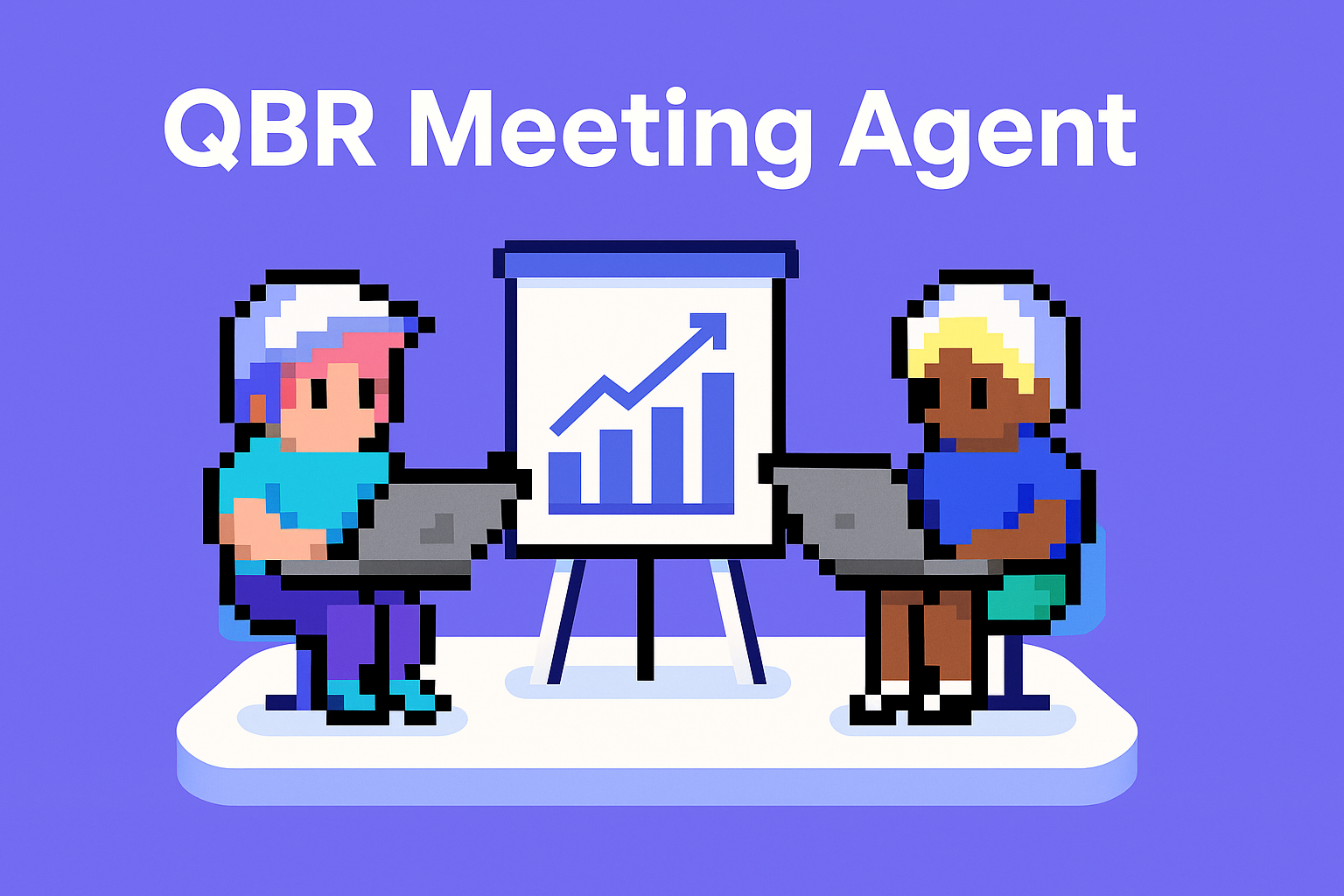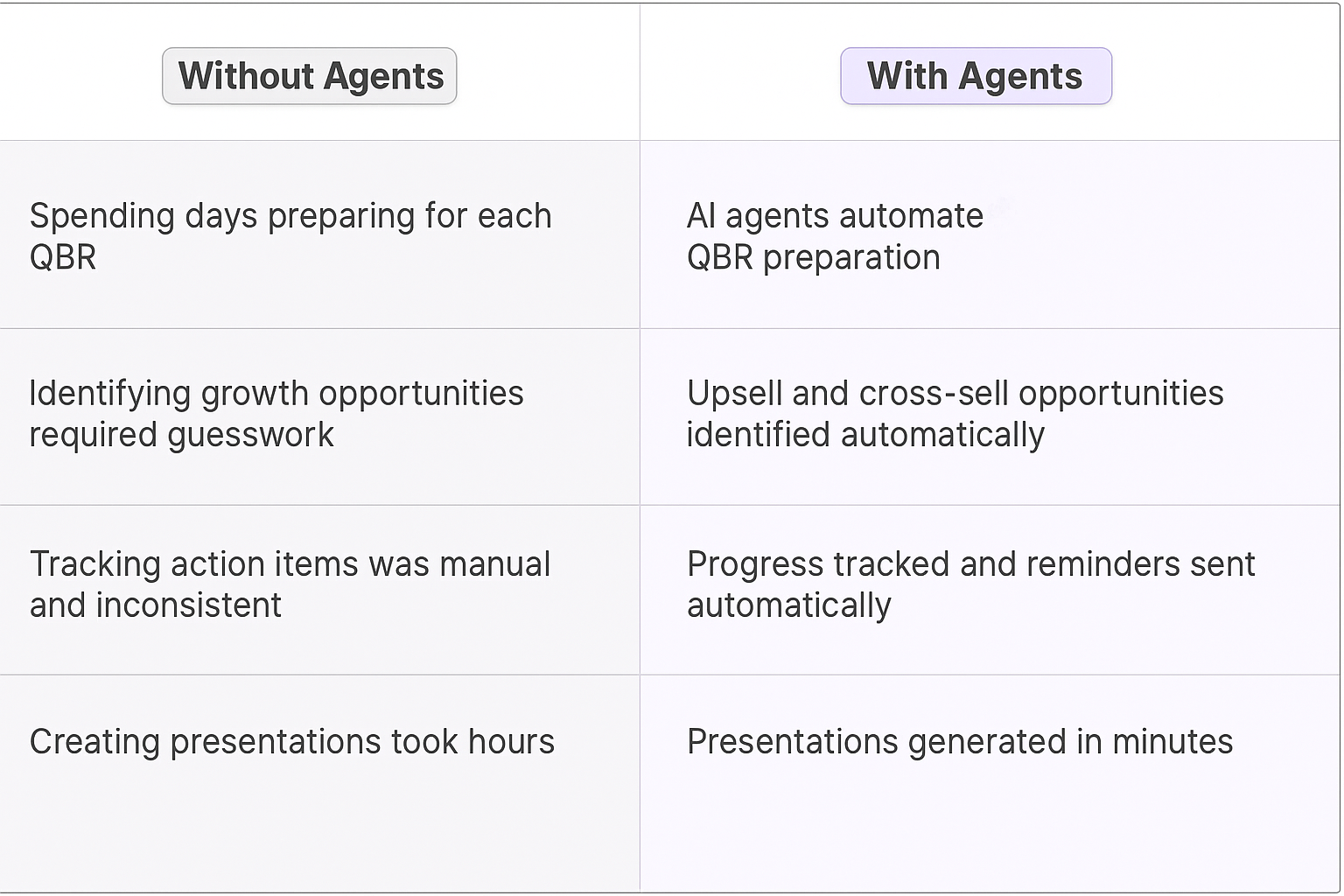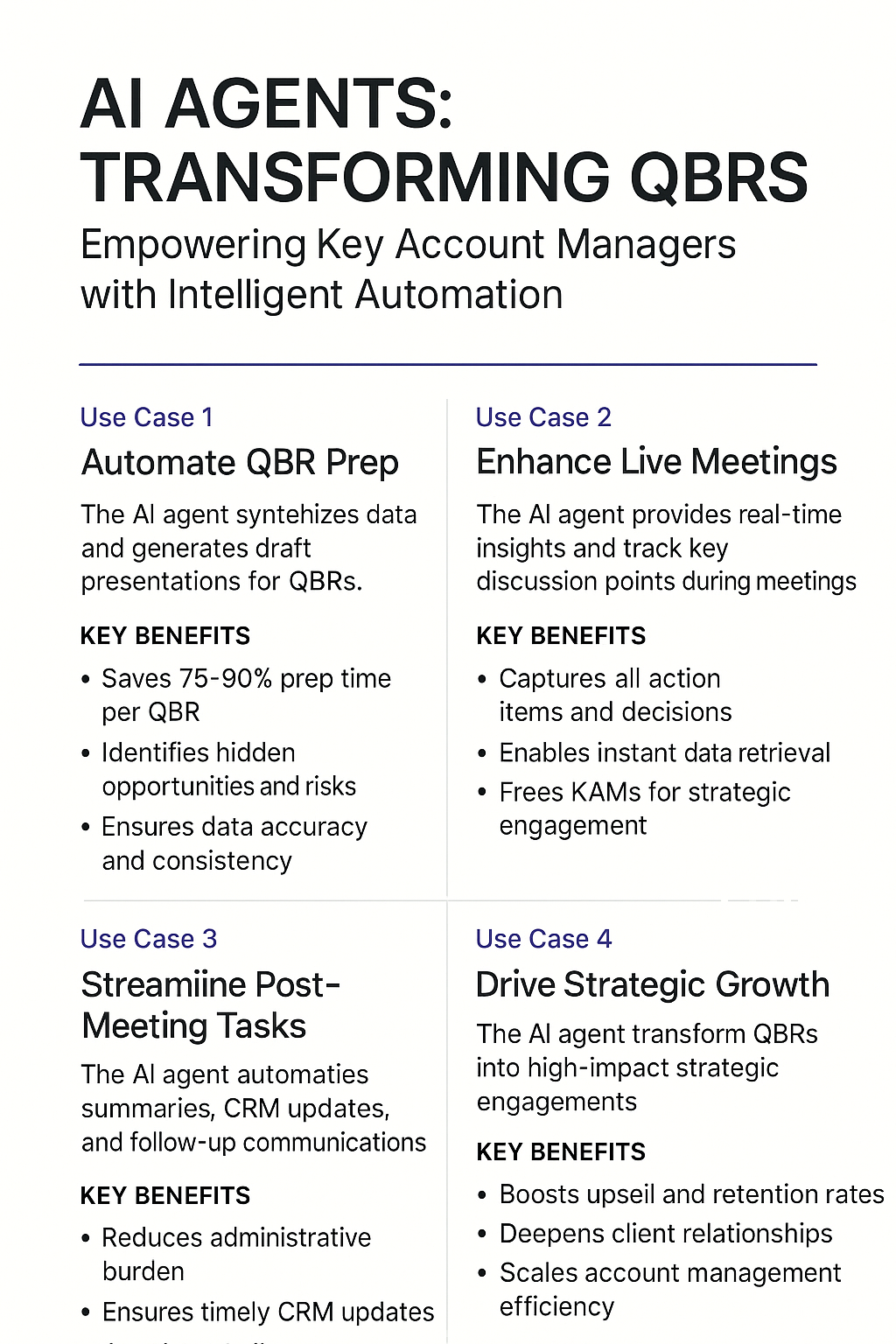
AI-powered QBR meeting agents are revolutionizing how Key Account Managers prepare for and conduct quarterly business reviews. These agents automate data compilation, identify growth opportunities, and generate compelling presentations, freeing up managers to focus on strategic discussions and building stronger client relationships. This technology streamlines workflows, enhances client engagement, and drives revenue growth.
Before Meeting
Before each QBR, your AI agent automatically gathers and analyzes key account data, including usage patterns, support ticket trends, feature adoption rates, and revenue metrics. It identifies potential upselling opportunities, churn risks, and strategic initiatives aligned with the client's business objectives.
During Meeting
During the QBR, your AI agent provides real-time insights and talking points, ensuring you stay focused on strategic discussions. It tracks action items, captures key decisions, and facilitates collaborative problem-solving.
After Meeting
Post-QBR, your AI agent generates a comprehensive summary of key takeaways, action items, and next steps. It automatically updates your CRM and project management tools, ensuring seamless follow-up and accountability.
What you’ll need
You don't need to be a developer to set up this integration. Follow this simple guide to get started:
- Meeting Notetaker Agent template
- Calendar account
- Meetings to join
- Relevance AI Account

Who this agent is for
This agent is designed for Key Account Managers, Customer Success Managers, Sales Directors, and anyone responsible for managing and growing key client relationships. It's ideal for individuals and teams who conduct regular Quarterly Business Reviews (QBRs) with strategic clients. Whether you're managing a portfolio of enterprise accounts or focusing on high-value partnerships, this agent simplifies QBR preparation, enhances client engagement, and drives revenue growth.
How this agent makes meeting planning easier
Automate data compilation and analysis
Instead of spending hours gathering data from various sources, the agent automatically compiles key account metrics, including usage patterns, support ticket trends, feature adoption rates, and revenue figures. It analyzes this data to identify trends, opportunities, and potential risks.
Generate customized QBR presentations
The agent automatically generates visually appealing and data-driven QBR presentations tailored to each client. These presentations highlight key achievements, demonstrate value delivered, and outline strategic recommendations for future growth.
Identify upselling and cross-selling opportunities
The agent analyzes client usage patterns and identifies potential upselling and cross-selling opportunities. It provides data-backed recommendations for expanding the client's product adoption and increasing revenue.
Track action items and ensure follow-up
The agent tracks action items from previous QBRs and provides status updates, ensuring continuity and accountability in the client relationship. It automatically generates follow-up tasks and reminders to ensure that commitments are met.
Benefits of AI Agents for Key Account Managers
What would have been used before AI Agents?
Key Account Managers traditionally relied on manual data gathering, spreadsheet analysis, and PowerPoint presentations to prepare for QBRs. This process was time-consuming, prone to errors, and often resulted in generic presentations that failed to resonate with clients. Managers would spend valuable time compiling data, creating charts, and formatting slides, taking away from their core responsibilities of client engagement and strategic planning.
What are the benefits of AI Agents?
AI agents offer a streamlined and automated approach to QBR preparation, freeing up Key Account Managers to focus on more strategic tasks. The most significant benefit is the time saved by automating data compilation and presentation generation. The agent handles everything from gathering metrics to creating visually appealing slides, reducing the administrative burden on the manager.
AI agents also improve the quality and consistency of QBR presentations. By using data-driven insights and customized talking points, the agent ensures that each presentation is relevant, engaging, and aligned with the client's business objectives. Furthermore, the agent enhances client engagement by providing real-time insights and facilitating collaborative problem-solving.
By integrating with existing CRM and project management tools, the agent provides a seamless and user-friendly experience. This eliminates the need for manual data entry and ensures that all QBR-related information is accurately recorded and easily accessible. Ultimately, AI agents enhance productivity, improve client relationships, and drive revenue growth.
Traditional vs Agentic meeting planning
Traditionally, Key Account Managers spent days preparing for each QBR, manually compiling data and creating presentations. Now, AI agents automate this, freeing up time for strategic client engagement. Before, identifying growth opportunities required extensive analysis and guesswork. With an agent, potential upselling and cross-selling opportunities are identified automatically, based on data-driven insights. Tracking action items used to be a manual task, often overlooked. Now, the agent automatically tracks progress and sends reminders, ensuring accountability. Creating customized presentations was a time-consuming process. The agent generates tailored presentations in minutes, saving hours of work. Finally, ensuring consistent messaging across all QBRs was a challenge. The agent provides standardized templates and talking points, ensuring a consistent and professional experience for every client.

Tasks that can be completed by a Meeting Planner Agent
Key Account Managers juggle numerous tasks, from building client relationships to driving revenue growth and ensuring client satisfaction. A meeting planner agent can handle many of the administrative tasks associated with QBR preparation and execution, allowing managers to focus on their core responsibilities.
Gathering and Analyzing Key Account Data
The agent automatically gathers data from various sources, including CRM, support tickets, usage analytics, and financial reports. It analyzes this data to identify trends, opportunities, and potential risks.
Generating Customized QBR Presentations
The agent automatically generates visually appealing and data-driven QBR presentations tailored to each client. These presentations highlight key achievements, demonstrate value delivered, and outline strategic recommendations for future growth.
Identifying Upselling and Cross-Selling Opportunities
The agent analyzes client usage patterns and identifies potential upselling and cross-selling opportunities. It provides data-backed recommendations for expanding the client's product adoption and increasing revenue.
Tracking Action Items and Ensuring Follow-Up
The agent tracks action items from previous QBRs and provides status updates, ensuring continuity and accountability in the client relationship. It automatically generates follow-up tasks and reminders to ensure that commitments are met.
Creating Meeting Agendas and Talking Points
The agent can create meeting agendas and talking points based on the client's specific needs and objectives. This ensures that the QBR is focused, productive, and aligned with the client's priorities.
Facilitating Collaborative Problem-Solving
The agent can facilitate collaborative problem-solving during the QBR by providing real-time insights, generating potential solutions, and tracking action items.
Generating Post-Meeting Summaries and Reports
The agent can generate post-meeting summaries and reports that capture key takeaways, action items, and next steps. These summaries can be automatically distributed to all participants.

Things to Keep in Mind When Building a Meeting Planner Agent
Building an effective QBR meeting planner agent requires careful planning and attention to detail. The goal is to create an agent that seamlessly integrates with your existing workflows and provides a user-friendly experience for all participants.
Define Clear Objectives
Before you start building your agent, define clear objectives for what you want it to achieve. Do you want to reduce QBR preparation time, improve presentation quality, enhance client engagement, or all of the above? Having clear objectives will help you prioritize features and measure success.
Integrate with Existing Systems
Ensure that your agent integrates seamlessly with your existing CRM, support ticket system, usage analytics platform, and other relevant tools. This will allow the agent to access the data it needs to generate accurate and insightful QBR presentations.
Prioritize Data Security and Privacy
Protect sensitive client data by implementing robust security measures and adhering to privacy regulations. Ensure that the agent is compliant with GDPR, CCPA, and other relevant data privacy laws.
Customize the Agent for Each Client
Allow users to customize the agent's settings to match the specific needs and objectives of each client. This might include selecting specific metrics to track, tailoring the presentation template, and configuring follow-up tasks.
Provide Training and Support
Provide training and support to Key Account Managers on how to use the agent effectively. This will help them maximize the benefits of the agent and ensure that they are comfortable using it.
Test Thoroughly
Before you roll out the agent to your entire team, test it thoroughly to ensure that it is working correctly and that it meets your objectives. Gather feedback from users and make any necessary adjustments.
Continuously Improve
Once your agent is live, continue to monitor its performance and gather feedback from users. Use this information to identify areas for improvement and make ongoing enhancements.
The Future of AI Agents in Meeting Planning
The future of AI agents in QBR meeting planning is bright, with advancements in natural language processing, machine learning, and artificial intelligence promising to further streamline and enhance the QBR process. Future agents will be able to understand complex client requests, anticipate potential challenges, and proactively suggest solutions.
AI agents will also become more personalized, learning individual client preferences and tailoring their recommendations accordingly. They will be able to identify preferred communication styles, preferred meeting formats, and even preferred presentation styles, creating a more seamless and engaging experience.
Furthermore, AI agents will play a larger role in facilitating collaboration and communication during QBRs. They will be able to transcribe meeting minutes, track action items, and even provide real-time translation services, making QBRs more productive and inclusive.
AI agents will also integrate with other business applications, such as project management tools and marketing automation platforms, providing a holistic view of client-related activities and enabling better decision-making.
Ultimately, the future of AI agents in QBR meeting planning is about creating intelligent systems that not only automate the QBR process but also enhance client relationships, drive revenue growth, and improve overall business outcomes.









